Assessment of Pozzolanic Activity of Ground Scoria Rocks under Low- and High-Pressure (Autoclave) Steam Curing
Abstract
:1. Introduction
2. Experimental Work
2.1. Materials
2.2. Mixing Procedure
2.3. Curing Regimes
2.3.1. Autoclave Curing
2.3.2. Steam Curing
2.4. Testing Procedure
3. Results and Discussion
3.1. Materials Characterization
3.2. High-Pressure Steam (Autoclave) Curing
3.2.1. Microstructural Analysis
3.2.2. Reaction Visualization
3.3. Low-Pressure Steam Curing
3.3.1. Thermogravimetric Analyses
3.3.2. FT-IR Analysis
3.3.3. XRD Analysis
3.4. Validation of the Findings
3.4.1. Fresh Properties
3.4.2. Hardened Properties
3.4.3. Temperature Profiles
3.4.4. Heat Flow and Heat of Hydration
3.4.5. Microstructural Analysis
4. Conclusions
- High-pressure steam curing (autoclave) is highly effective with materials containing tectosilicate minerals, namely 3D-framework structures, which convert to tobermorite under such conditions. The materials with single-chain silicate structures, on the other hand, did not generate tobermorite alone, which forms an enhanced type of tobermorite crystals in the presence of crystalline GFS.
- Under low-pressure steam curing of NP and CH, the estimated amounts of the remaining CH in the NP1 and NP2 were about 7.1 and 5.1%, respectively, which means that 72 and 80% of portlandite, respectively, is consumed in the pozzolanic reaction.
- In normal concrete mixes, the control mix (CTRL) has the highest peak value of the temperature profiles, followed by the NP2 mix, which has a substantial temperature gap when compared to the inert GFS mix. This temperature behavior was attributed to NP2’s pozzolanic reactivity.
- When compared to the control concrete mix, the strength activity indices of NP1, NP2, and class F fly ash in their normal concrete mixes reached 74.3%, 82%, and 73.7%, respectively, after 56 days of normal curing conditions.
Author Contributions
Funding
Institutional Review Board Statement
Informed Consent Statement
Data Availability Statement
Acknowledgments
Conflicts of Interest
References
- Fares, G.; Alhozaimy, A.; Al-Negheimish, A.; Alawad, O.A. Characterization of scoria rock from Arabian lava fields as natural pozzolan for use in concrete. Eur. J. Environ. Civ. Eng. 2022, 26, 39–57. [Google Scholar] [CrossRef]
- Shannag, M.J.; Charif, A.; Dghaither, S. Developing Structural Lightweight Concrete Using Volcanic Scoria Available in Saudi Arabia. Arab. J. Sci. Eng. 2014, 39, 3525–3534. [Google Scholar] [CrossRef]
- Tchamdjou, W.H.J.; Grigoletto, S.; Michel, F.; Courard, L.; Abidi, M.L.; Cherradi, T. An investigation on the use of coarse volcanic scoria as sand in Portland cement mortar. Case Stud. Constr. Mater. 2017, 7, 191–206. [Google Scholar] [CrossRef]
- Al-Swaidani, A.M. Volcanic Scoria as Cement Replacement. In Volcanoes-Geological and Geophysical Setting, Theoretical Aspects and Numerical Modeling, Applications to Industry and Their Impact on the Human Health; Aiello, G., Ed.; IntechOpen: London, UK, 2018; Available online: https://www.intechopen.com/chapters/61544 (accessed on 21 May 2022).
- Sarıdemir, M.; Bulut, M. Effects of ground basaltic pumice and high temperatures on the properties of HSMs. J. Build. Eng. 2021, 41, 102772. [Google Scholar] [CrossRef]
- Celik, K.; Jackson, M.D.; Mancio, M.; Meral, C.; Emwas, A.M.; Mehta, P.K.; Monteiro, P.J. High-volume natural volcanic pozzolan and limestone powder as partial replacements for portland cement in self-compacting and sustainable concrete. Cem. Concr. Compos. 2014, 45, 136–147. [Google Scholar] [CrossRef] [Green Version]
- Abbas, Y.M.; Khan, M.I. Optimization of Arabian-Shield-Based Natural Pozzolan and Silica Fume for High-Performance Concrete Using Statistical Design of Experiments. Adv. Civ. Eng. 2021, 2021, 5512666. [Google Scholar] [CrossRef]
- Khan, M.I.; Alhozaimy, A.M. Properties of natural pozzolan and its potential utilization in environmental friendly concrete. Can. J. Civ. Eng. 2011, 38, 71–78. [Google Scholar] [CrossRef]
- Kapeluszna, E.; Szudek, W.; Wolka, P.; Zieliński, A. Implementation of Alternative Mineral Additives in Low-Emission Sustainable Cement Composites. Materials 2021, 14, 6423. [Google Scholar] [CrossRef]
- Najafi, E.; Allahverdi, A. Effects of curing time and temperature on strength development of inorganic polymeric binder based on natural pozzolan. J. Mater. Sci. 2009, 44, 3088–3097. [Google Scholar] [CrossRef]
- Fang, Y.; Wang, J.; Wang, X.; Amaral, M.L.D.; Kniffin, H.; Reed, M.; Wang, L.; Qian, X. Bio-Based Admixture (Black Tea Extraction) for Better Performance of Metakaolin Blended Cement Mortars. Materials 2022, 15, 3994. [Google Scholar] [CrossRef]
- Barreto, E.D.S.; Stafanato, K.V.; Marvila, M.T.; de Azevedo, A.R.G.; Ali, M.; Pereira, R.M.L.; Monteiro, S.N. Clay Ceramic Waste as Pozzolan Constituent in Cement for Structural Concrete. Materials 2021, 14, 2917. [Google Scholar] [CrossRef] [PubMed]
- Alawad, O.A.; Alhozaimy, A.; Jaafar, M.S.; Abdul Aziz, F.N.; Al-Negeimish, A. Effect of Autoclave Curing on the Microstructure of Blended Cement Mixture Incorporating Ground Dune Sand and Ground Granulated Blast Furnace Slag. Int. J. Concr. Struct. Mater. 2015, 9, 381–390. [Google Scholar] [CrossRef] [Green Version]
- Alhozaimy, A.; Alawad, O.A.; Jaafar, M.S.; AL-Negheimish, A.; Noorzaei, J. Use of fine ground dune sand as a supplementary cementing material. J. Civ. Eng. Manag. 2014, 20, 32–37. [Google Scholar] [CrossRef]
- Alhozaimy, A.; Fares, G.; Al-Negheimish, A.; Jaafar, M.S. The autoclaved concrete industry: An easy-to-follow method for optimization and testing. Constr. Build. Mater. 2013, 49, 184–193. [Google Scholar] [CrossRef] [Green Version]
- Kalousek, G.L. Studies on the cementious phases of autoclaved concrete products made of different raw materials. ACI J. Proc. 1954, 50, 365–378. [Google Scholar]
- Yazıcı, H.; Yiğiter, H.; Aydın, S.; Baradan, B. Autoclaved SIFCON with high volume class C fly ash binder phase. Cem. Concr. Res. 2016, 36, 48–486. [Google Scholar] [CrossRef]
- Liu, Z.; Bu, L.; Wang, Z.; Hu, G. Durability and microstructure of steam cured and autoclaved PHC pipe piles. Constr. Build. Mater. 2019, 209, 679–689. [Google Scholar] [CrossRef]
- Li, G.; Zhuang, Z.; Lv, Y.; Wang, K.; Hui, D. Enhancing carbonation and chloride resistance of autoclaved concrete by incorporating nano-CaCO3. Nanotechnol. Rev. 2020, 9, 998–1008. [Google Scholar] [CrossRef]
- Nelubova, V.; Strokova, V.; Fediuk, R.; Amran, M.; Vatin, N.; Vasilev, Y. Effect of an aluminosilicate disperse additive on behaviors of autoclave silicate materials. Buildings 2021, 11, 239. [Google Scholar] [CrossRef]
- Taylor, H.F. Proposed structure for calcium silicate hydrate gel. J. Am. Ceram. Soc. 1986, 69, 464–467. [Google Scholar] [CrossRef]
- Richardson, I.G. The calcium silicate hydrates. Cem. Concr. Res. 2008, 38, 137–158. [Google Scholar] [CrossRef]
- Grangeon, S.; Fernandez-Martinez, A.; Baronnet, A.; Marty, N.; Poulain, A.; Elkaim, E.; Roosz, C.; Gaboreau, S.; Henocq, P.; Claret, F. Quantitative X-ray pair distribution function analysis of nanocrystalline calcium silicate hydrates: A contribution to the understanding of cement chemistry. J. Appl. Crystallogr. 2017, 50, 14–21. [Google Scholar] [CrossRef]
- Mohamed, A.K.; Parker, S.C.; Bowen, P.; Galmarini, S. An atomistic building block description of CSH-towards a realistic CSH model. Cem. Concr. Res. 2018, 107, 221–235. [Google Scholar] [CrossRef]
- Yu, P.; Kirkpatrick, R.J.; Poe, B.; McMillan, P.F.; Cong, X. Structure of calcium silicate hydrate (C-S-H): Near-, mid-, and far-infrared spectroscopy. J. Am. Ceram. Soc. 1999, 82, 742–748. [Google Scholar] [CrossRef]
- Riding, K.A.; Poole, J.L.; Schindler, A.K.; Juenger, M.C.G.; Folliard, K.J. Evaluation of Temperature Prediction Methods for Mass Concrete Members. ACI Mater. J. 2006, 103, 357–365. [Google Scholar] [CrossRef] [Green Version]
- Livesey, P.; Donnelly, A.; Tomlinson, C. Measurement of the heat of hydration of cement. Cem. Concr. Compos. 1991, 13, 177–185. [Google Scholar] [CrossRef]
- Chung, C.-W.; Kim, J.H.; Lee, S.-Y. The Use of Semi-Adiabatic Calorimetry for Hydration Studies of Cement Paste. J. Korea Inst. Build. Constr. 2016, 16, 185–192. [Google Scholar] [CrossRef] [Green Version]
- Gutteridge, W.A.; Dalziel, J.A. Filler cement: The effect of the secondary component on the hydration of Portland cement: Part I. A fine non-hydraulic filler. Cem. Concr. Res. 1990, 20, 778–782. [Google Scholar] [CrossRef]
- Cyr, M.; Lawrence, P.; Ringot, E. Mineral admixtures in mortars: Quantification of the physical effects of inert materials on short-term hydration. Cem. Concr. Res. 2005, 35, 719–730. [Google Scholar] [CrossRef]
- Berodier, E.; Scrivener, K.L. Understanding the filler effect on the nucleation and growth of C–S–H. J. Am. Ceram. Soc. 2014, 97, 3764–3773. [Google Scholar] [CrossRef]

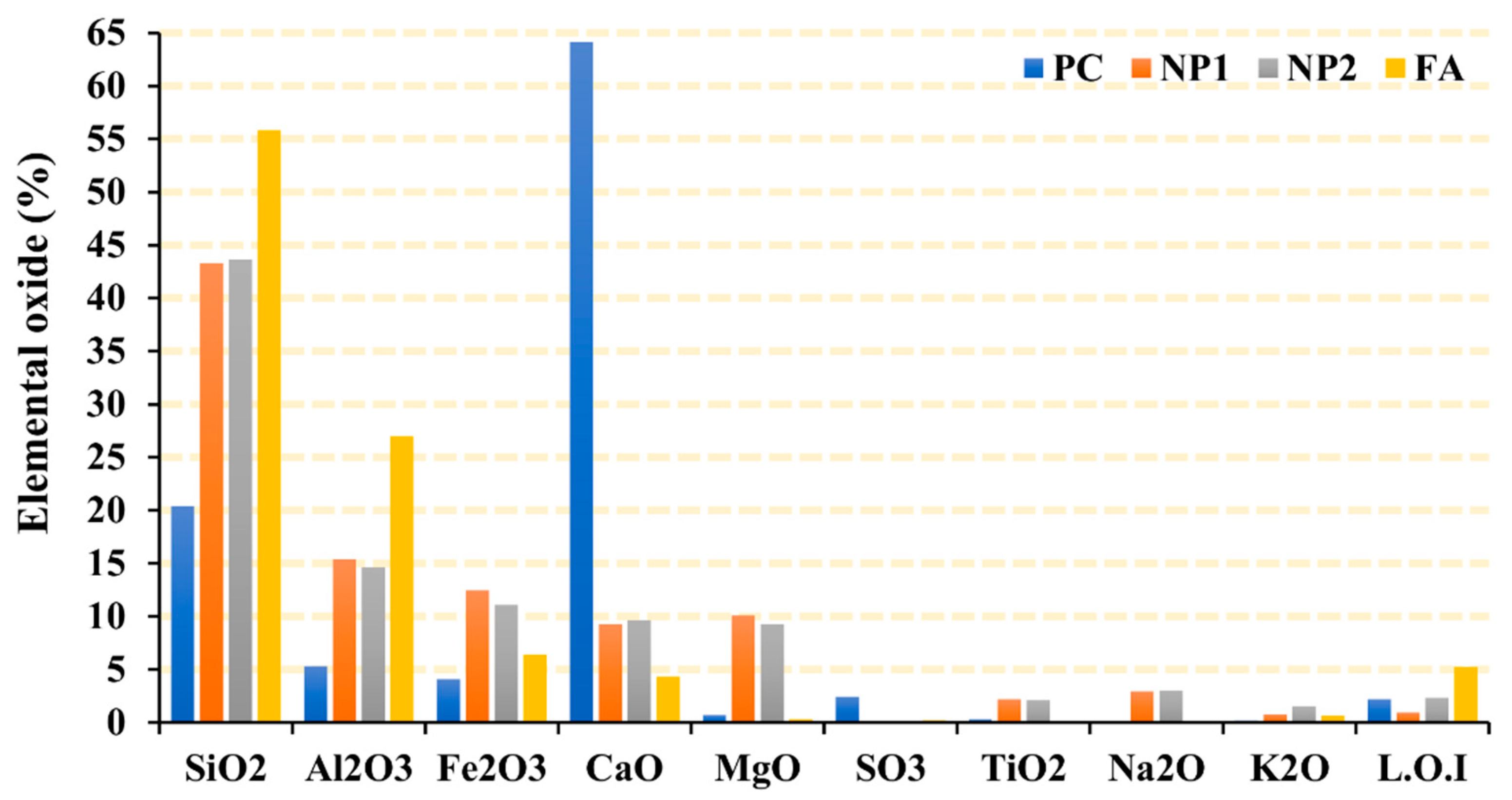
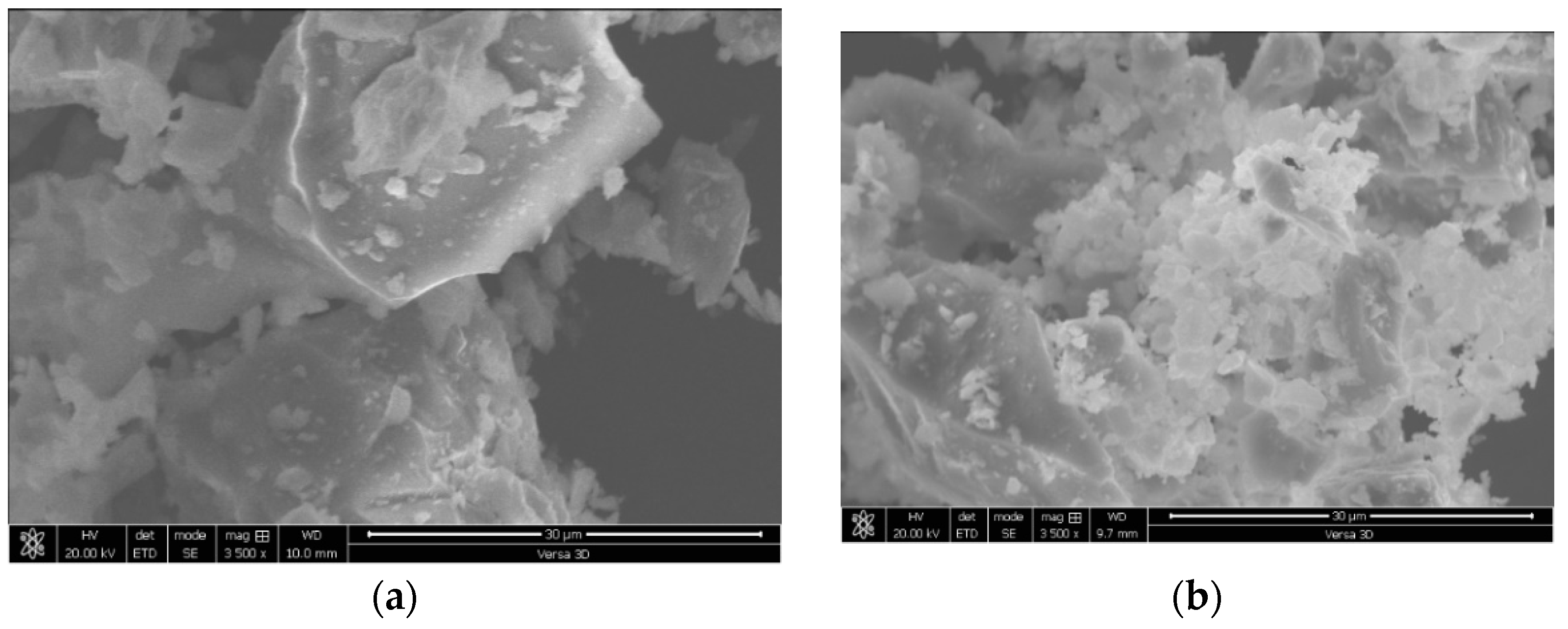
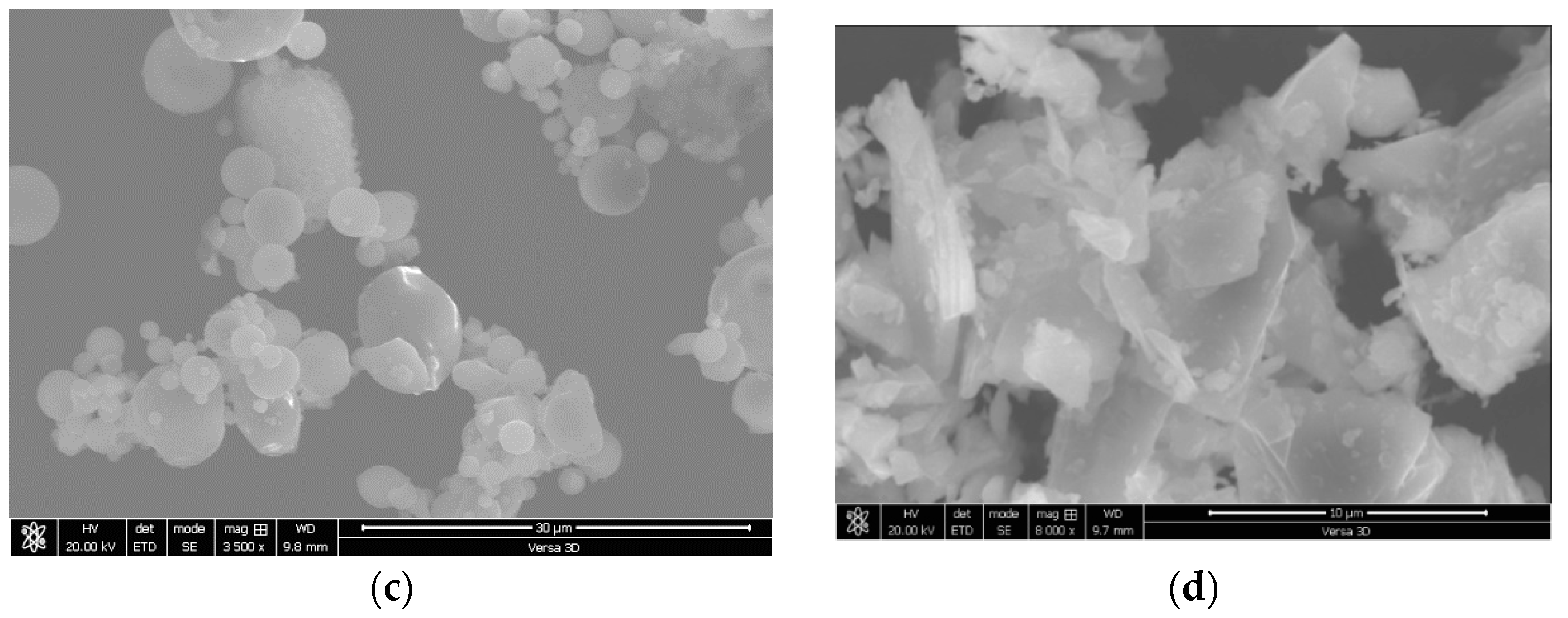
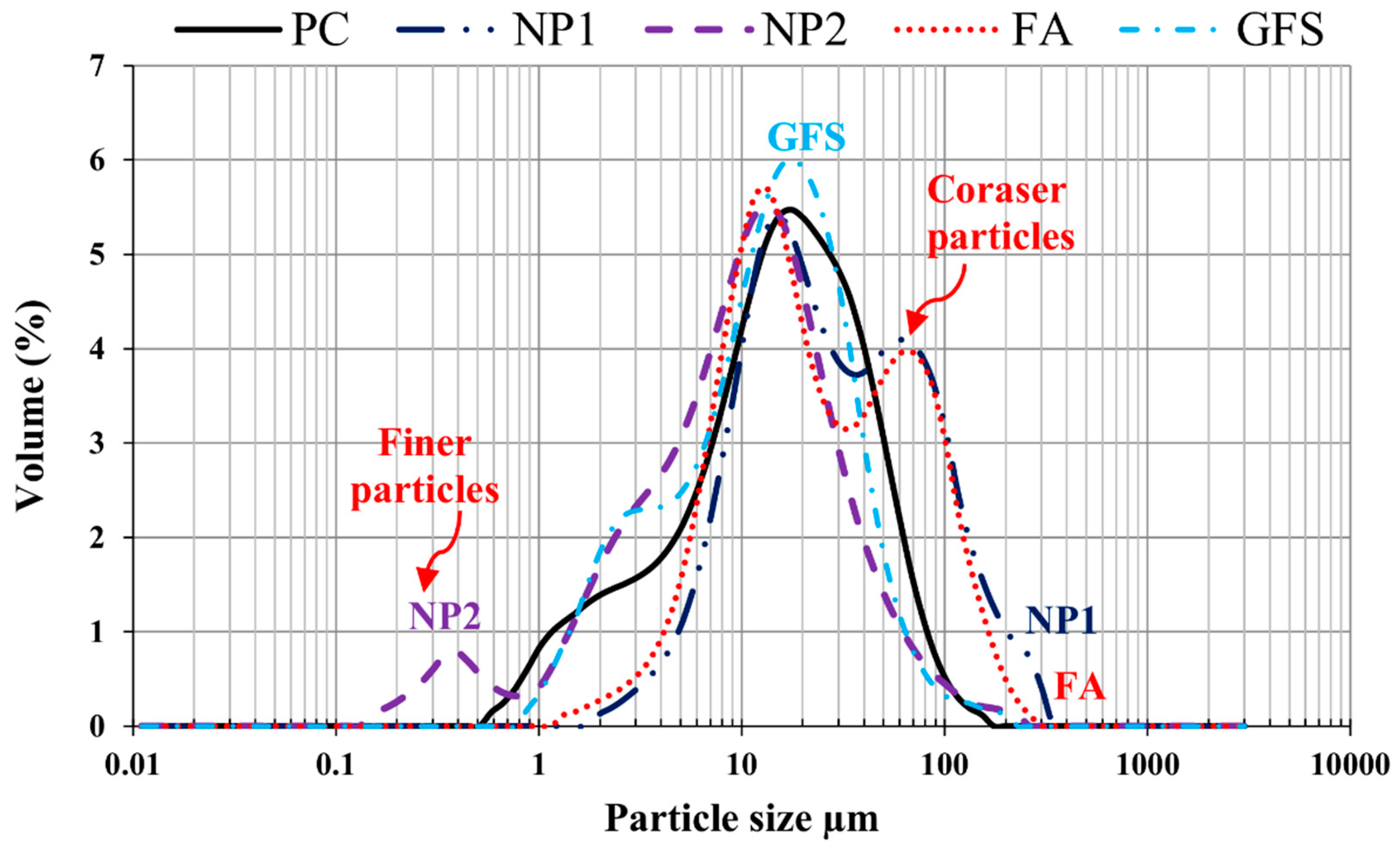
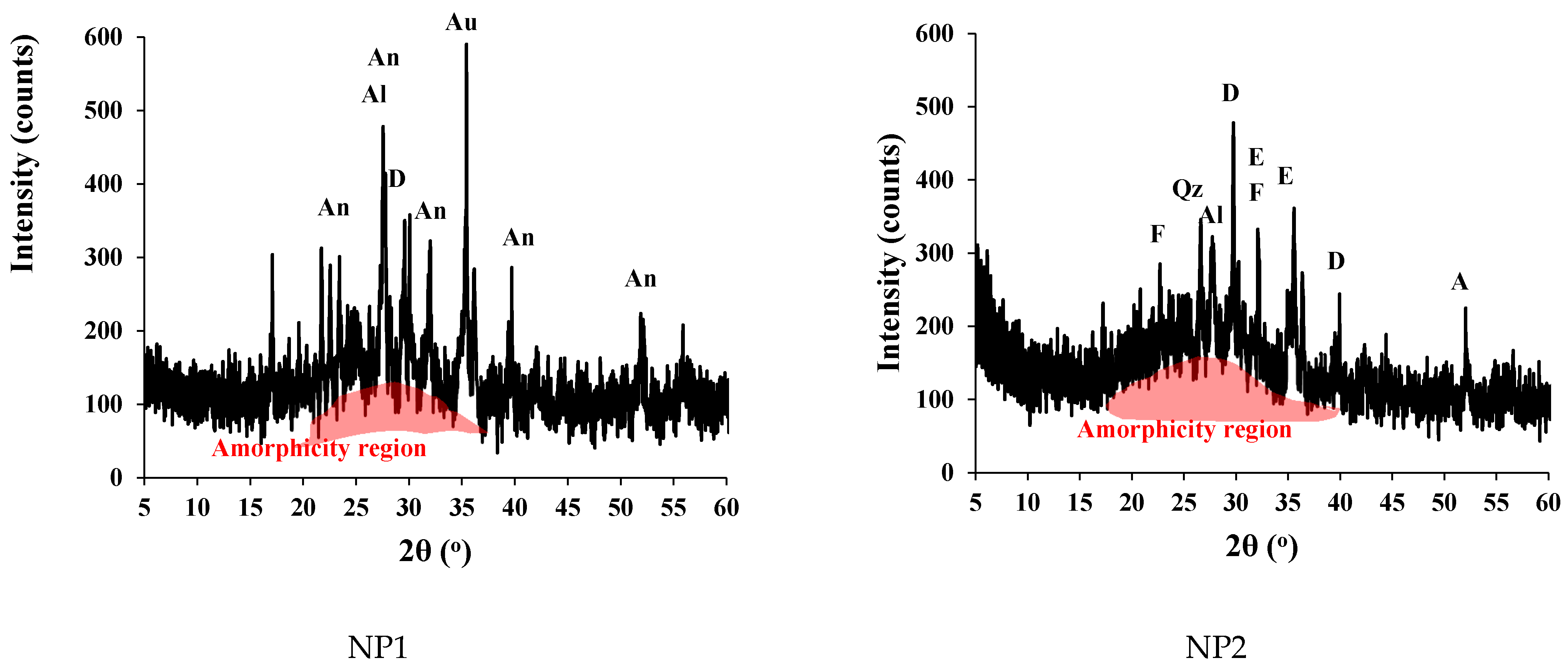
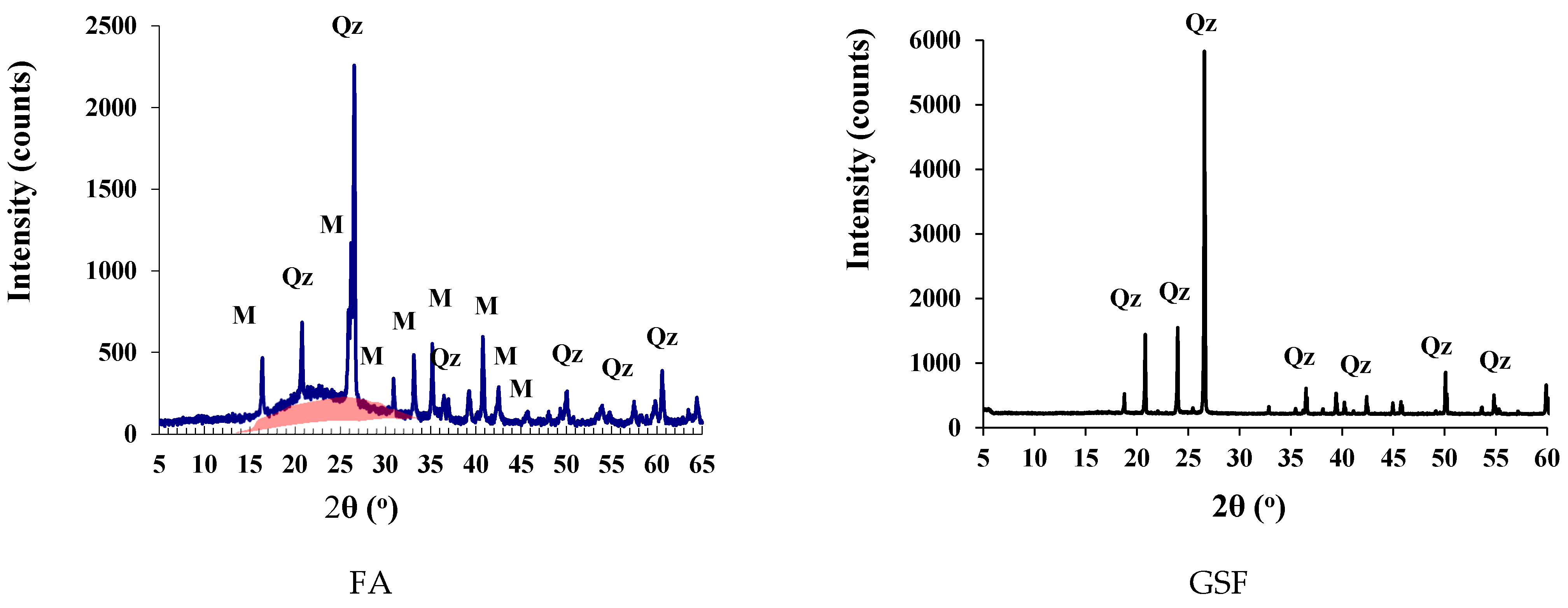
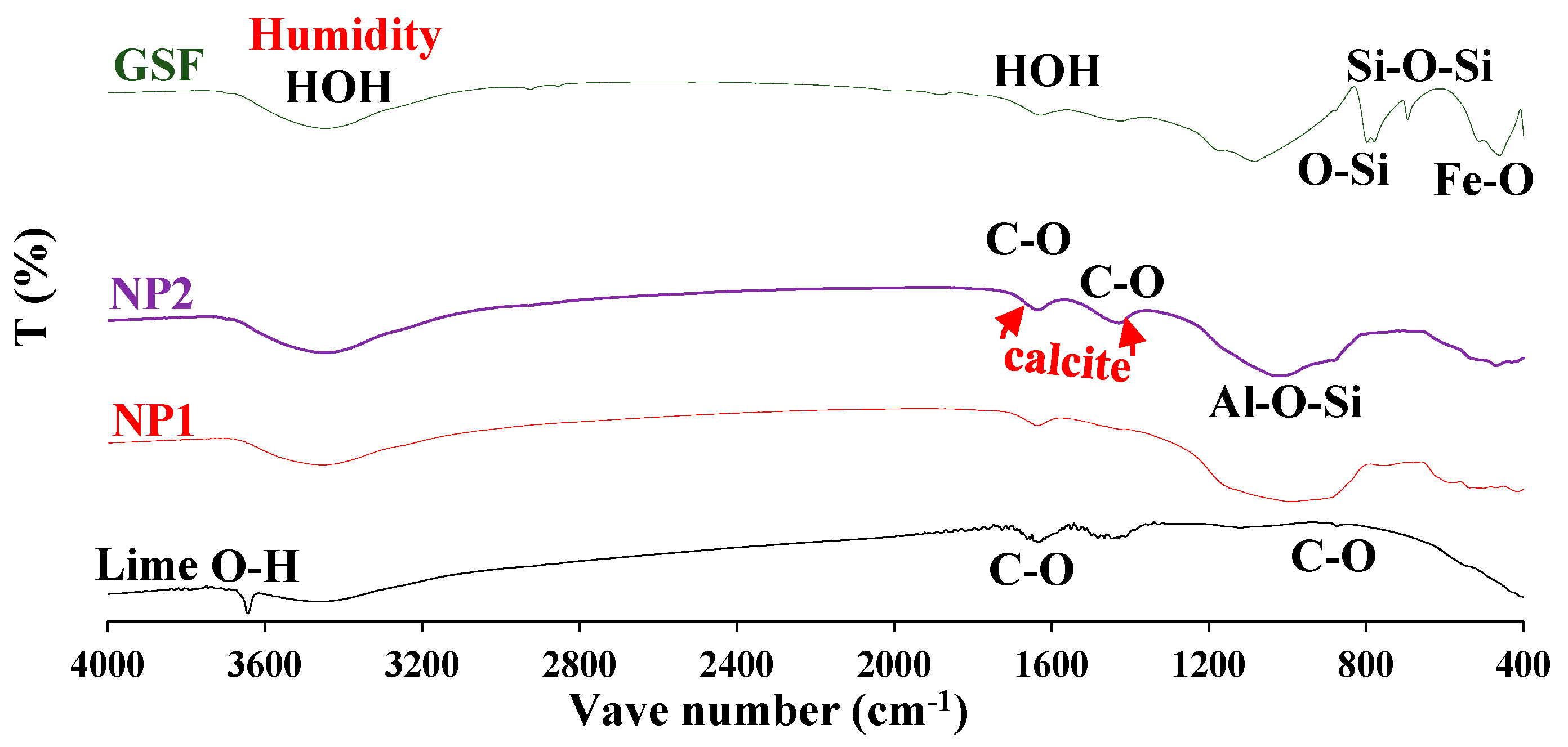
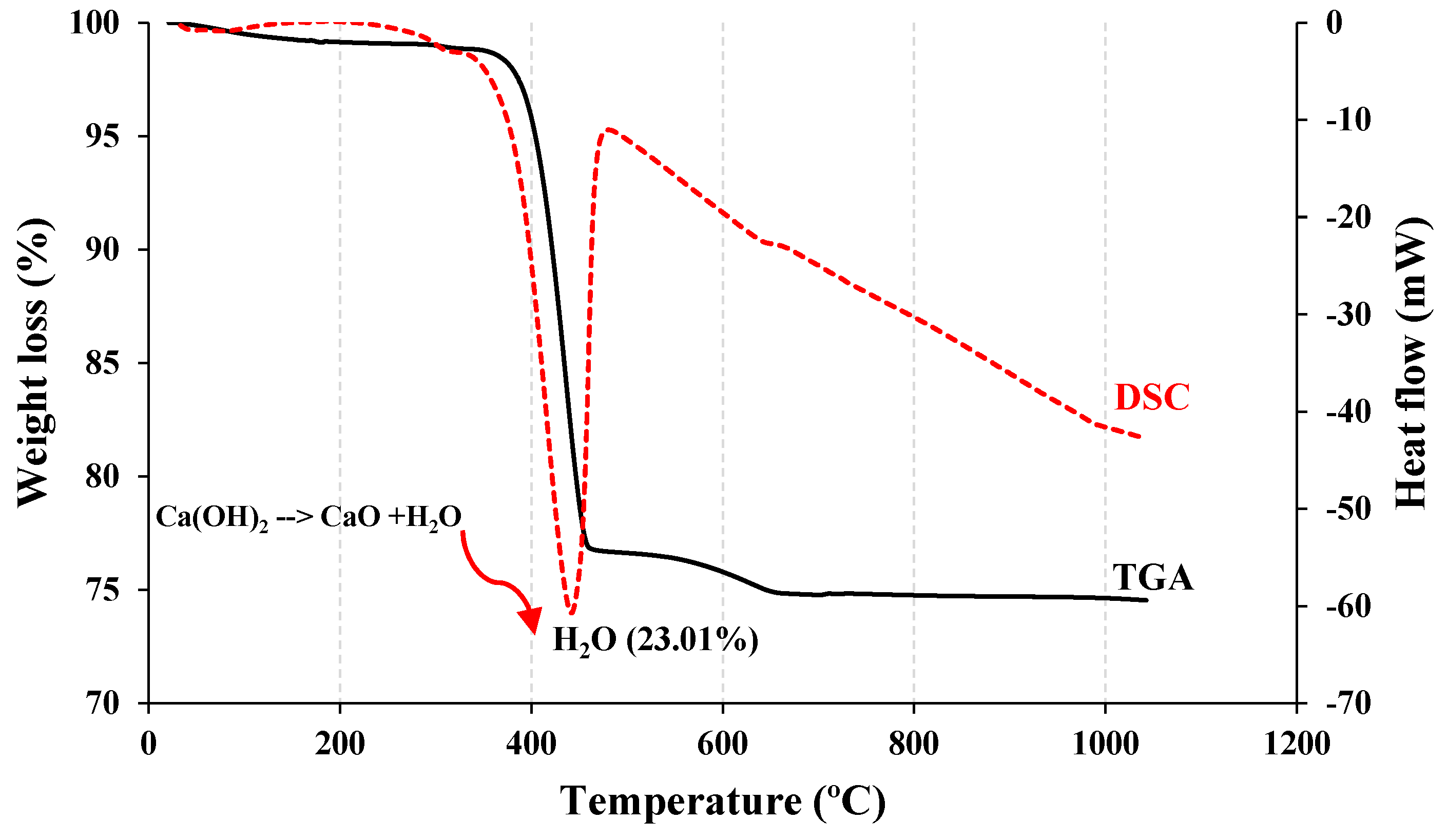
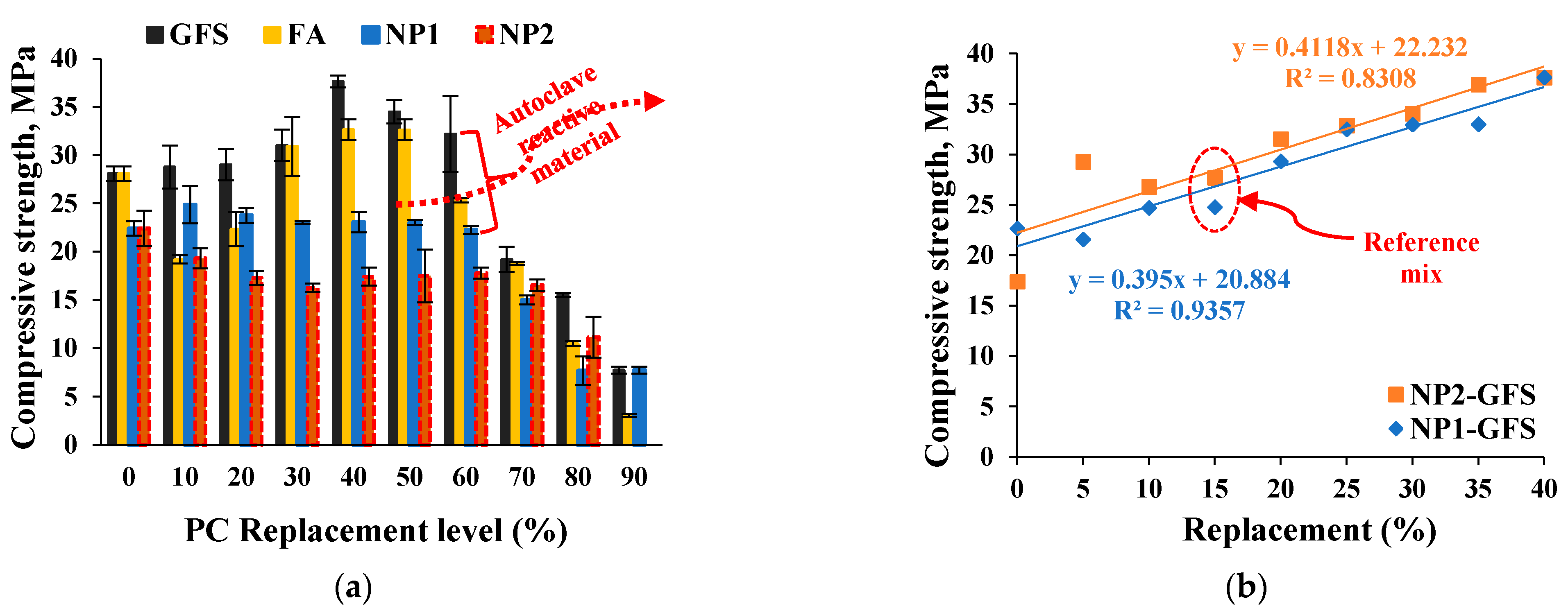

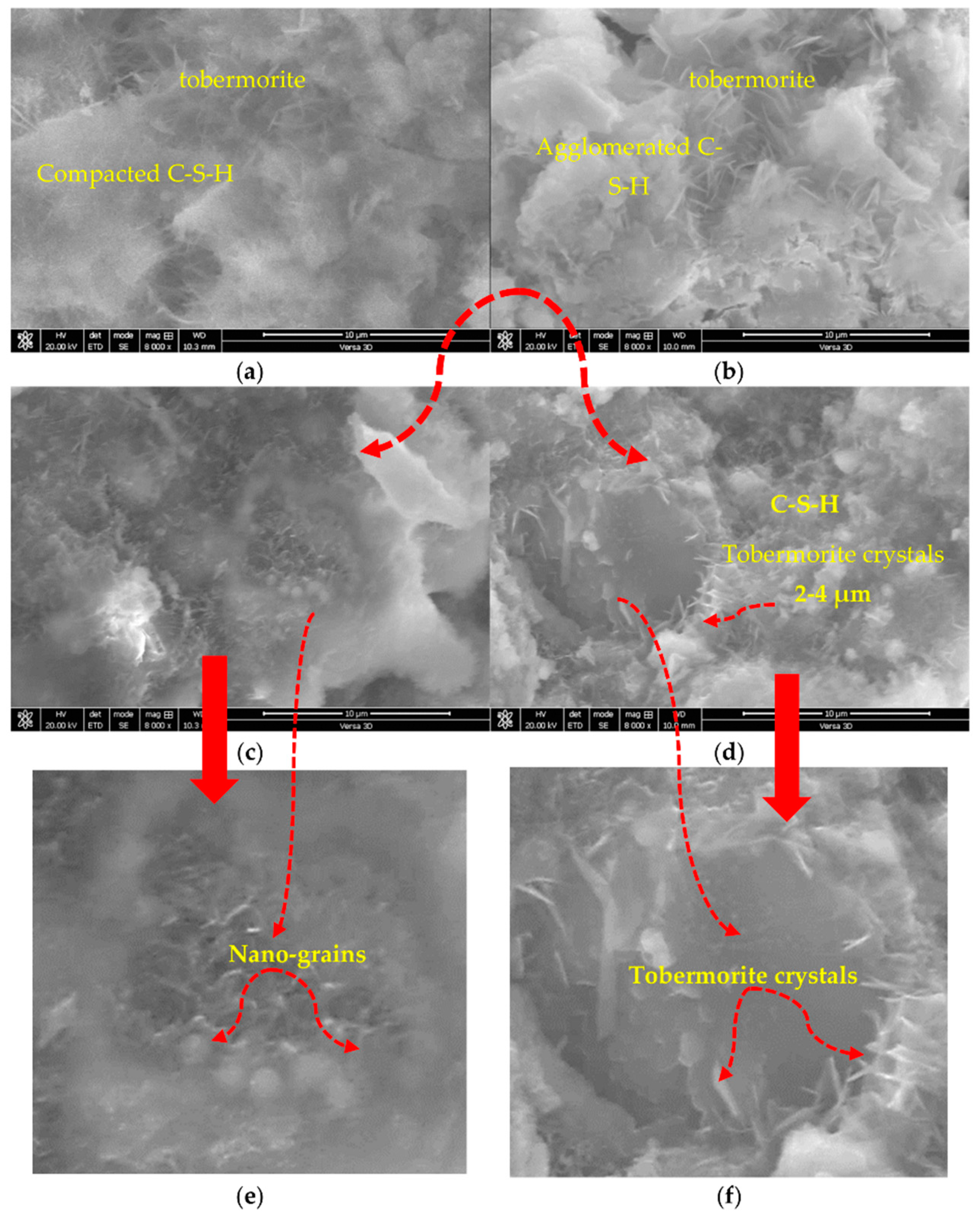
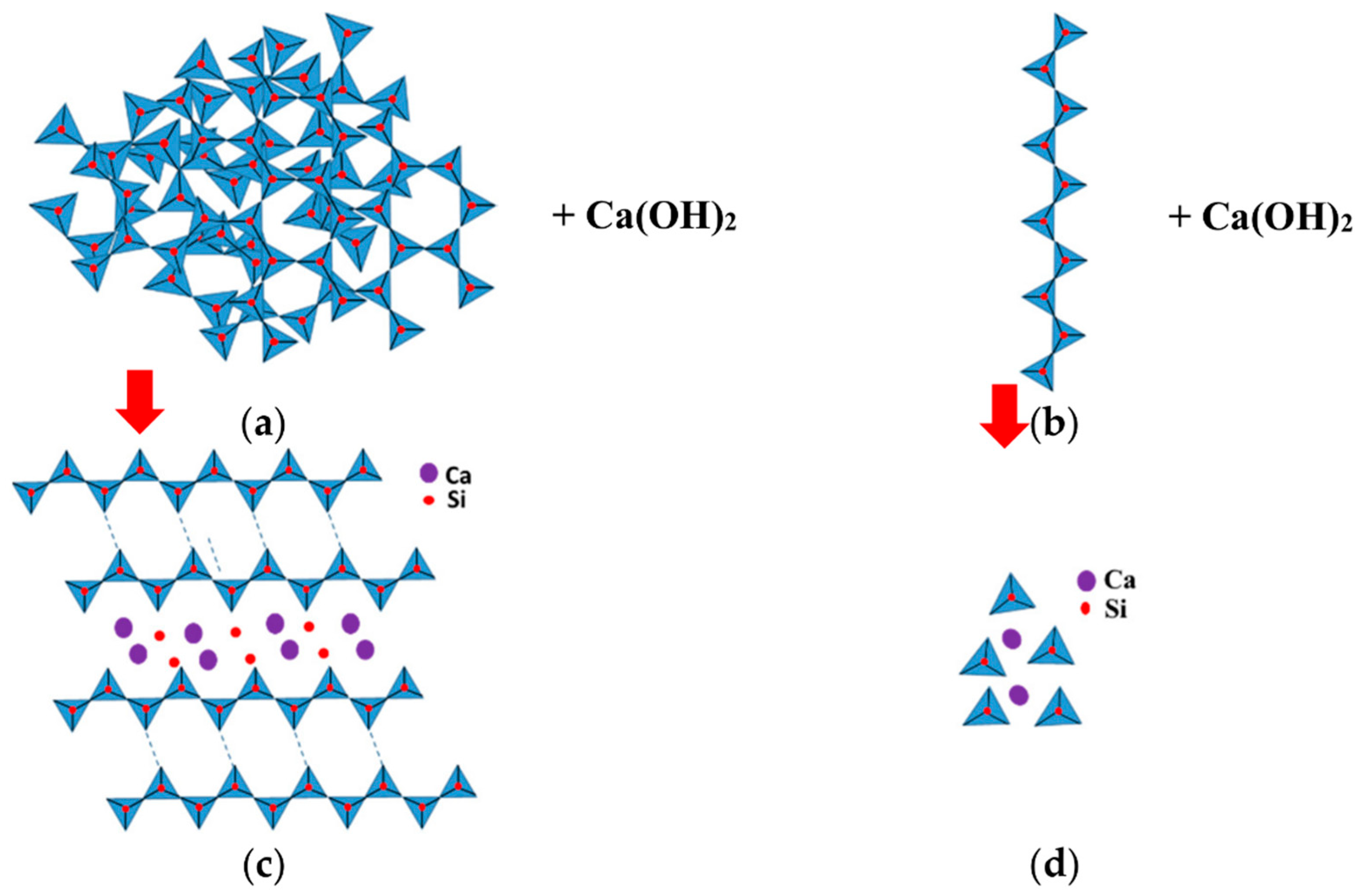
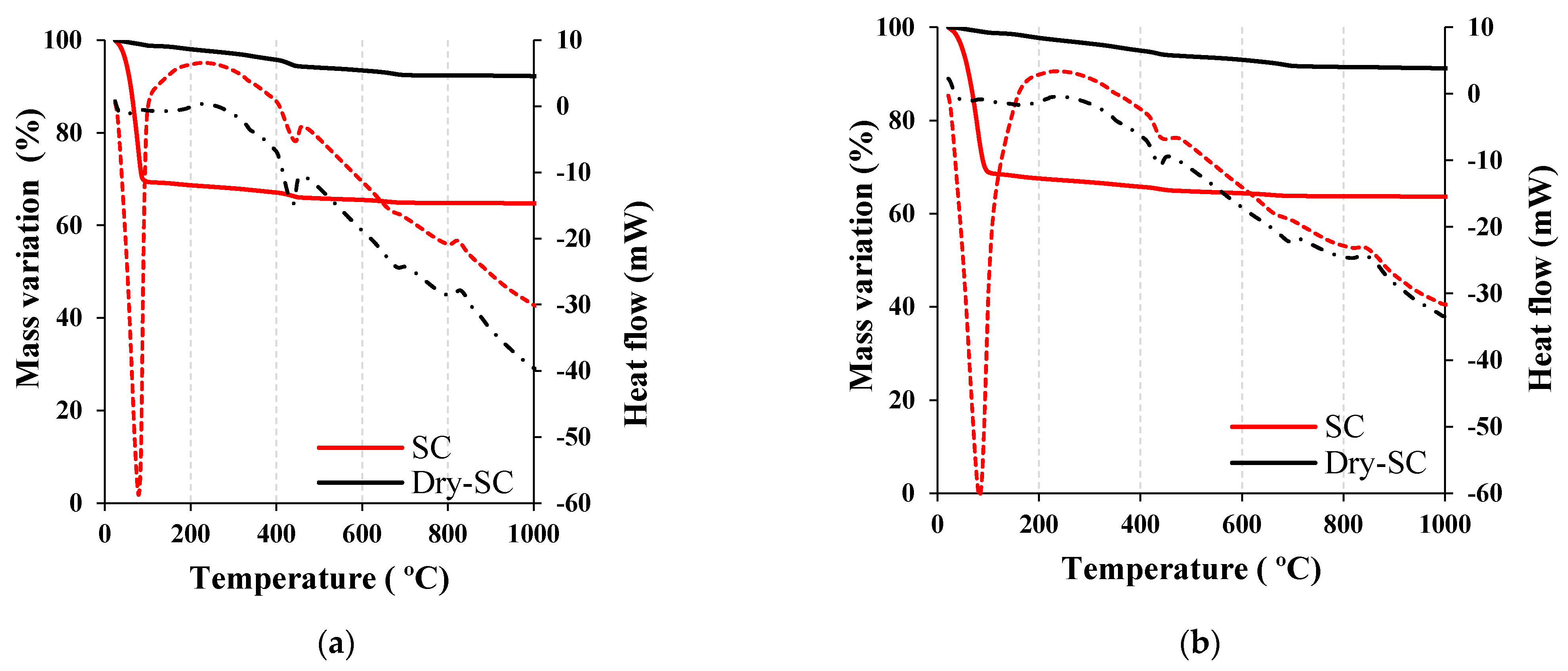
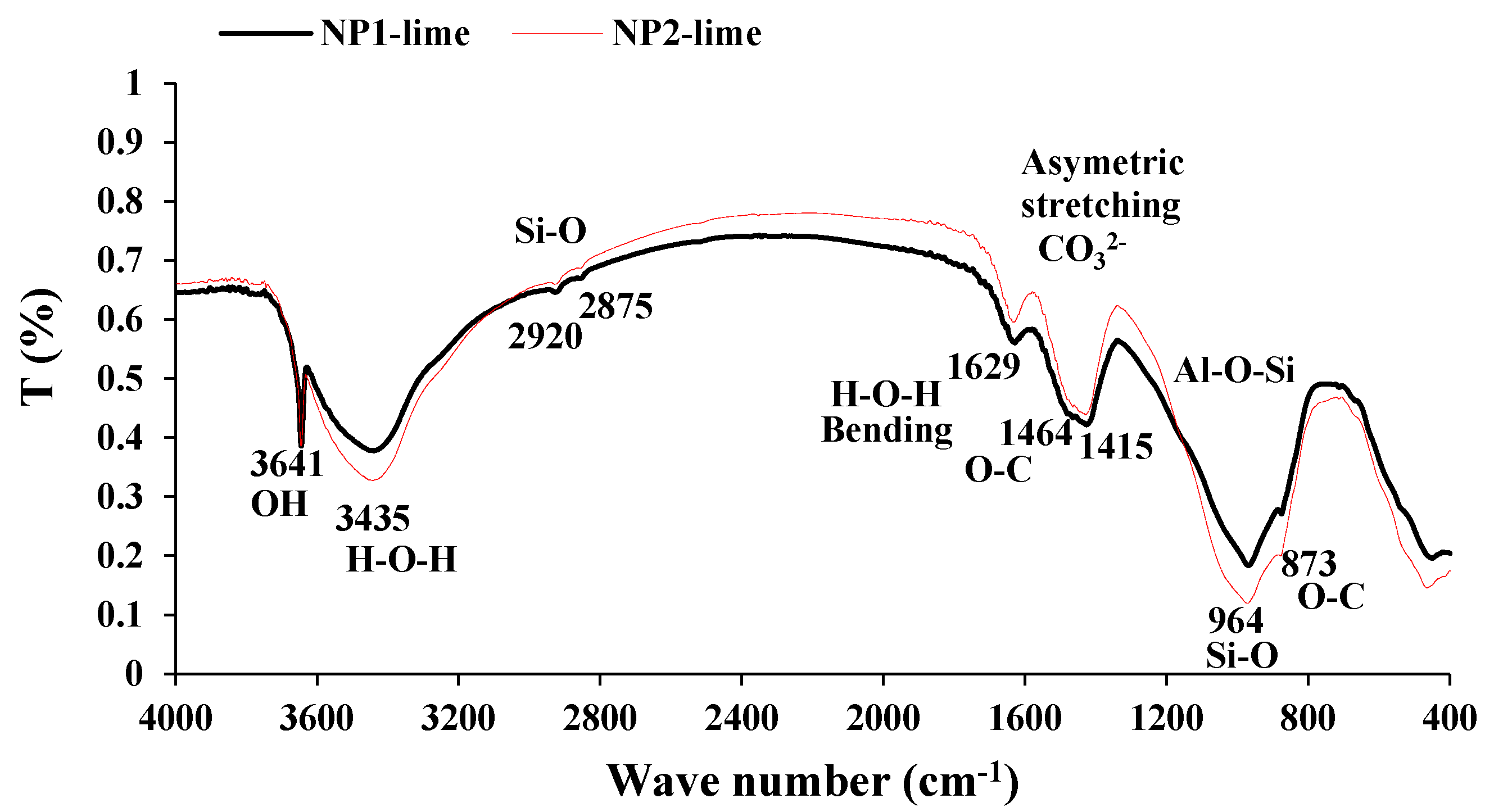
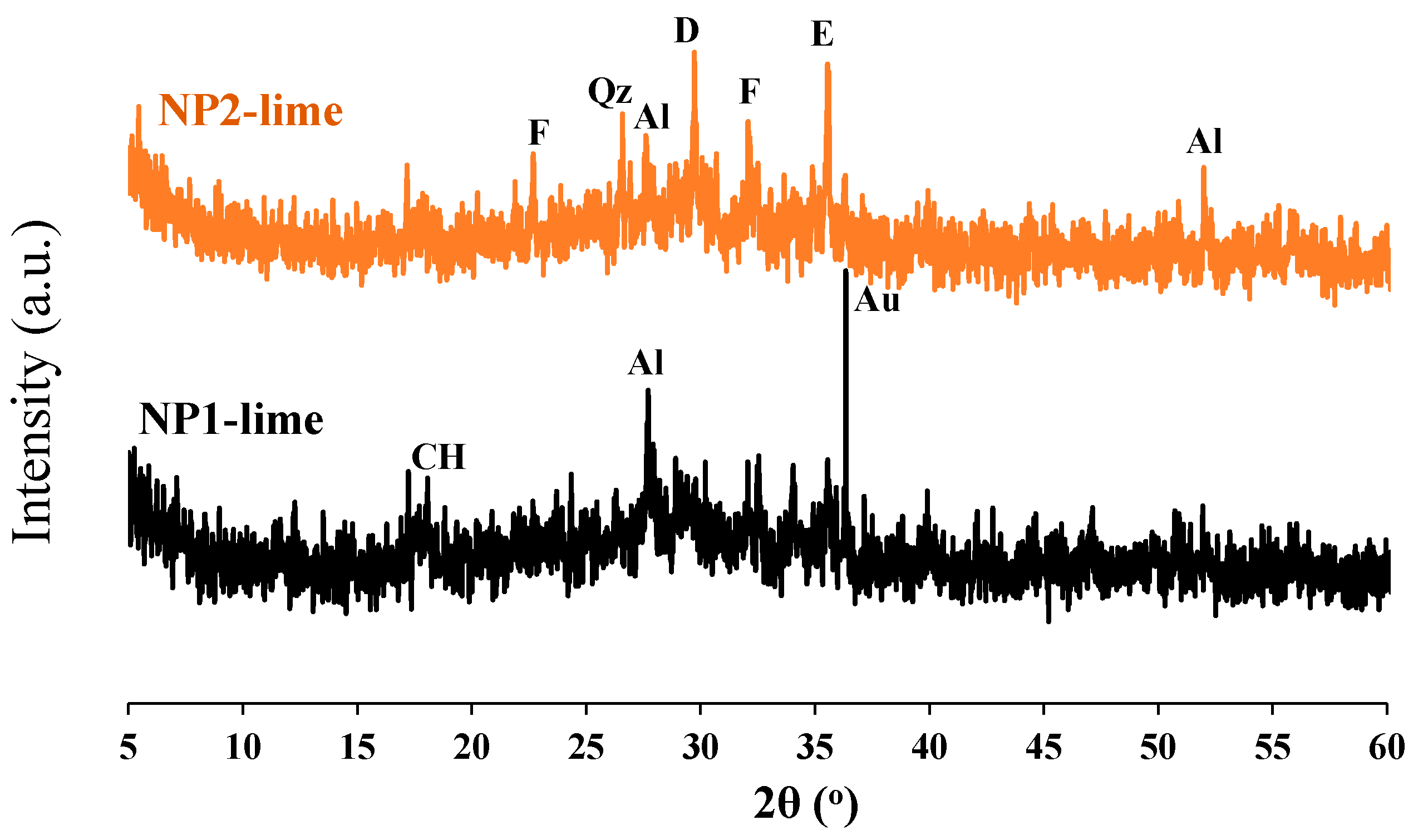
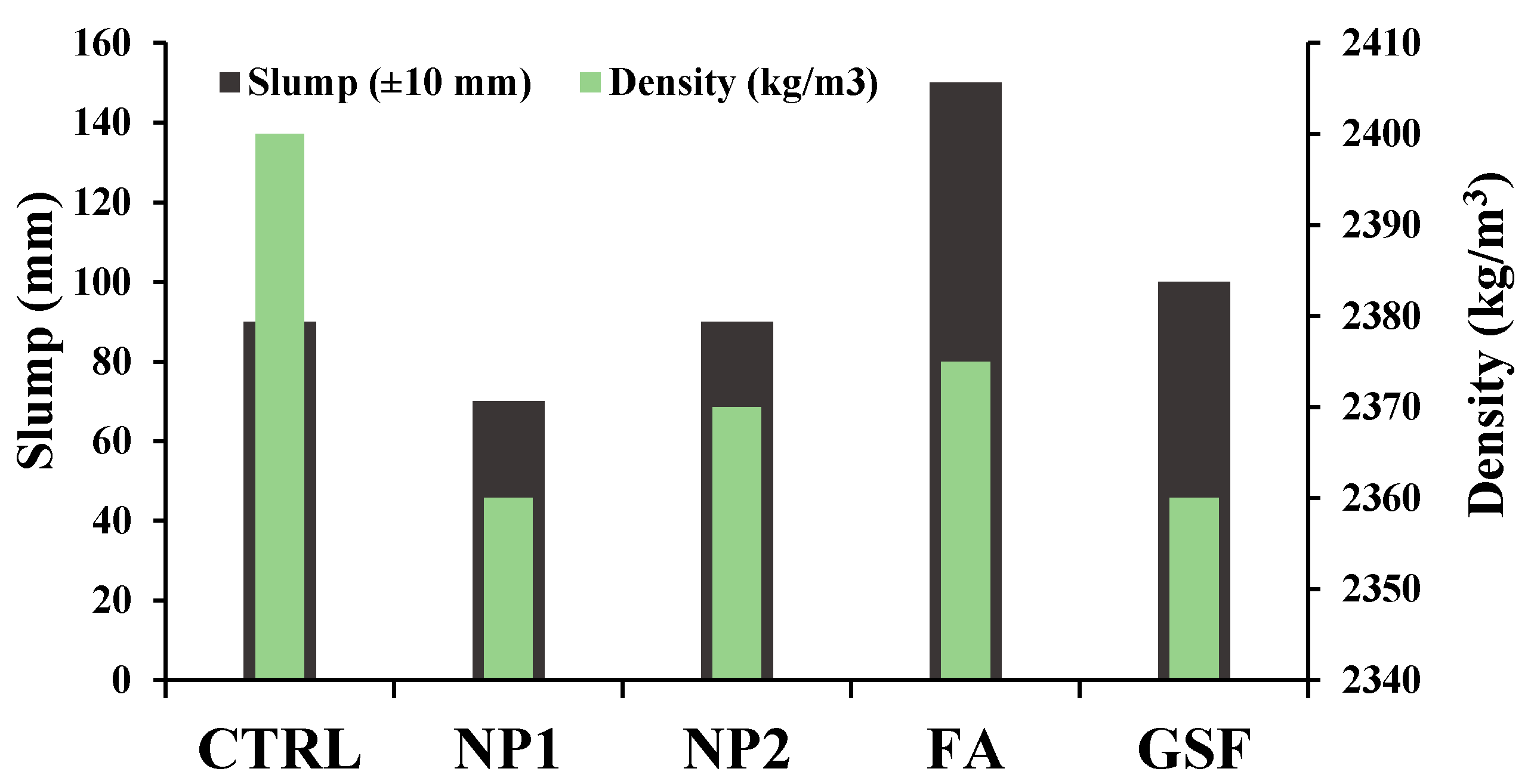
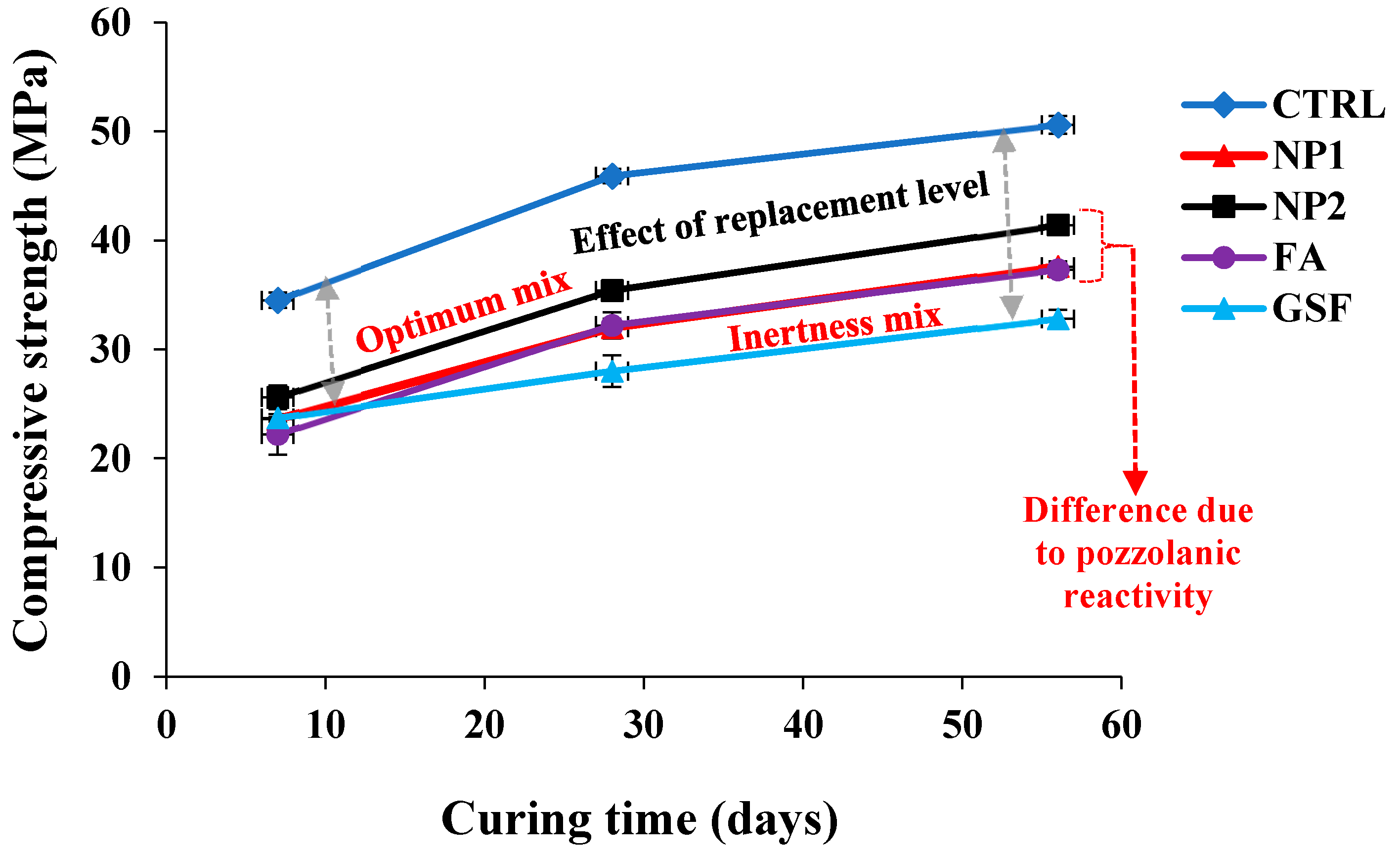
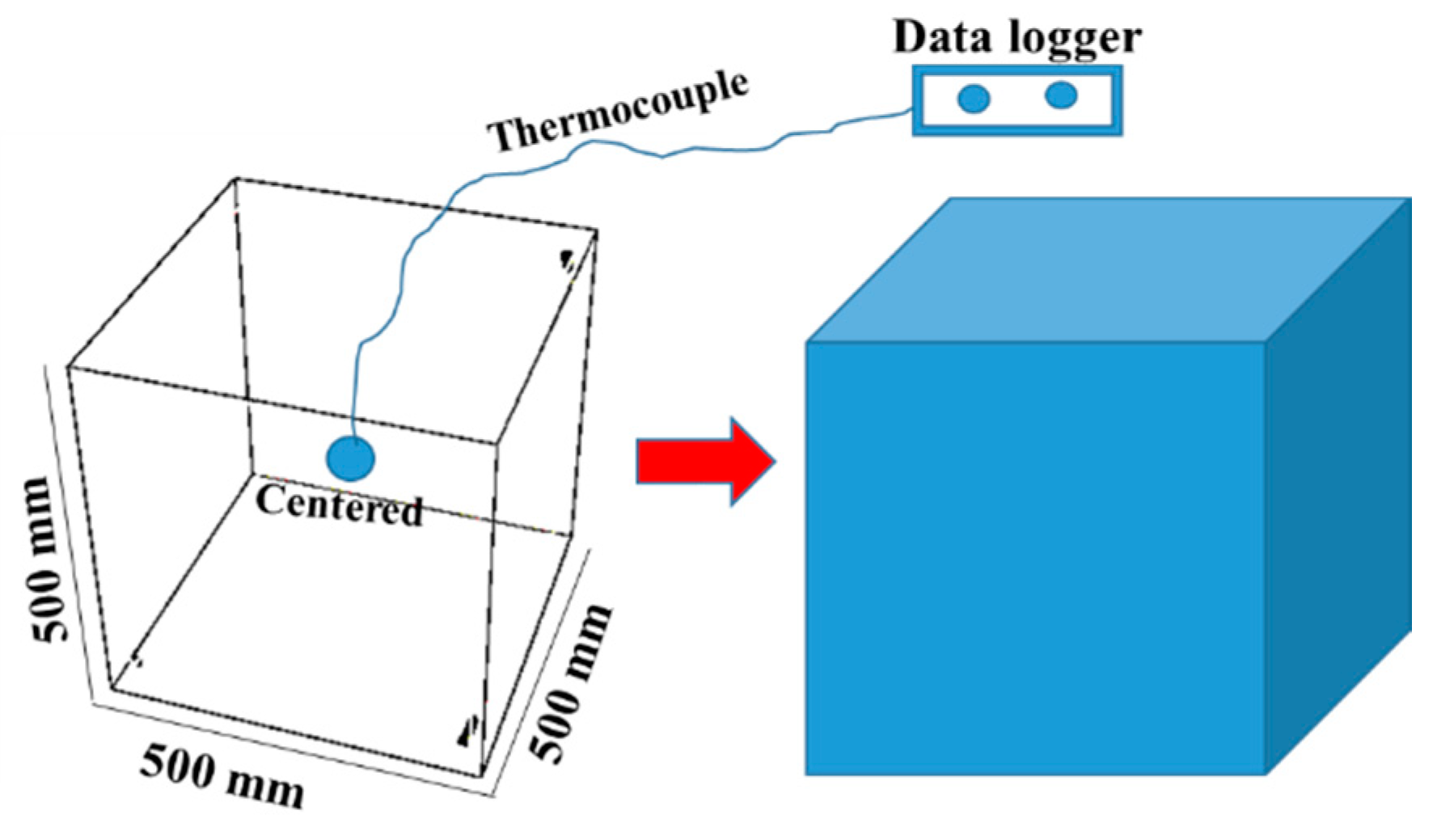
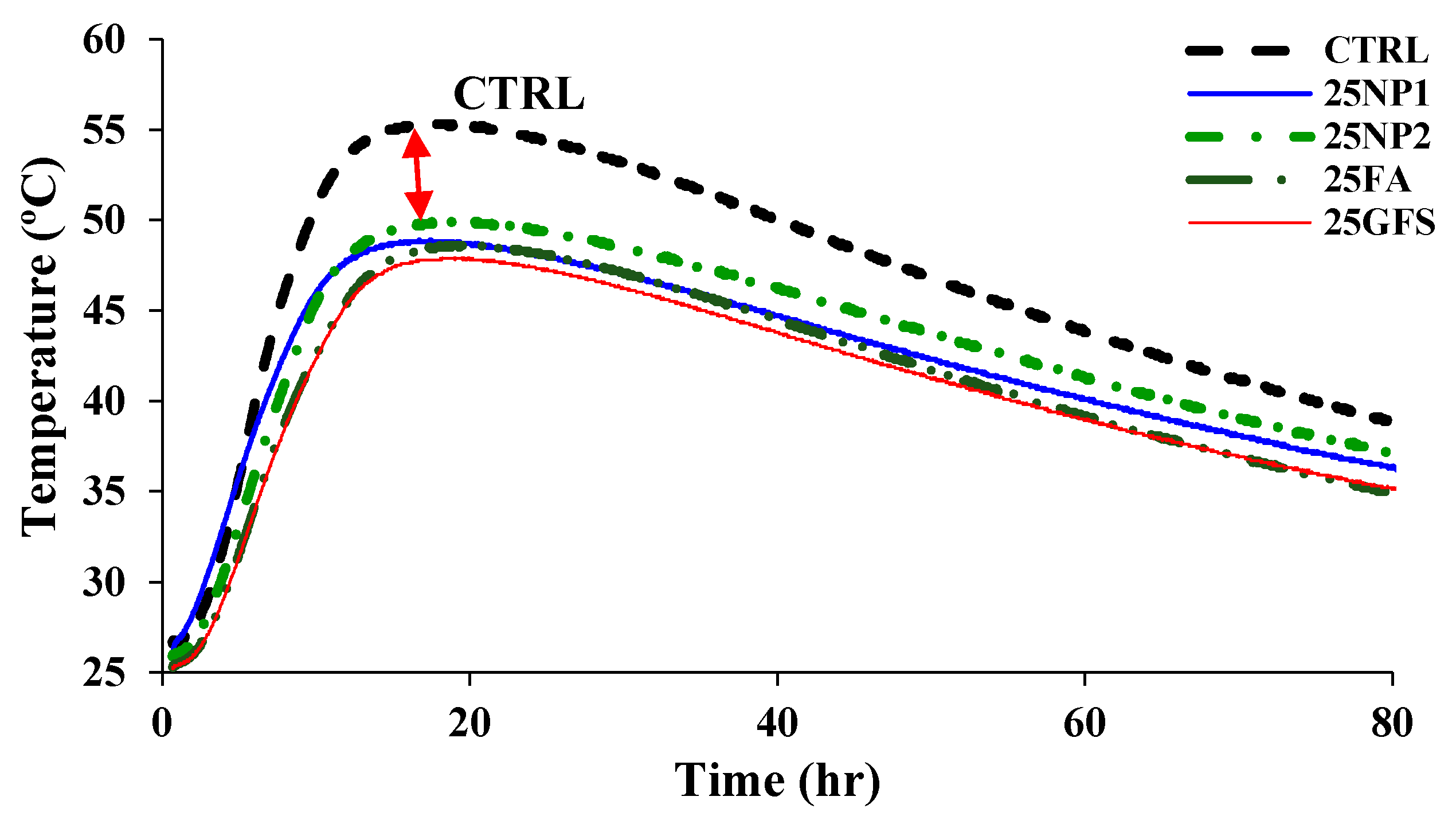
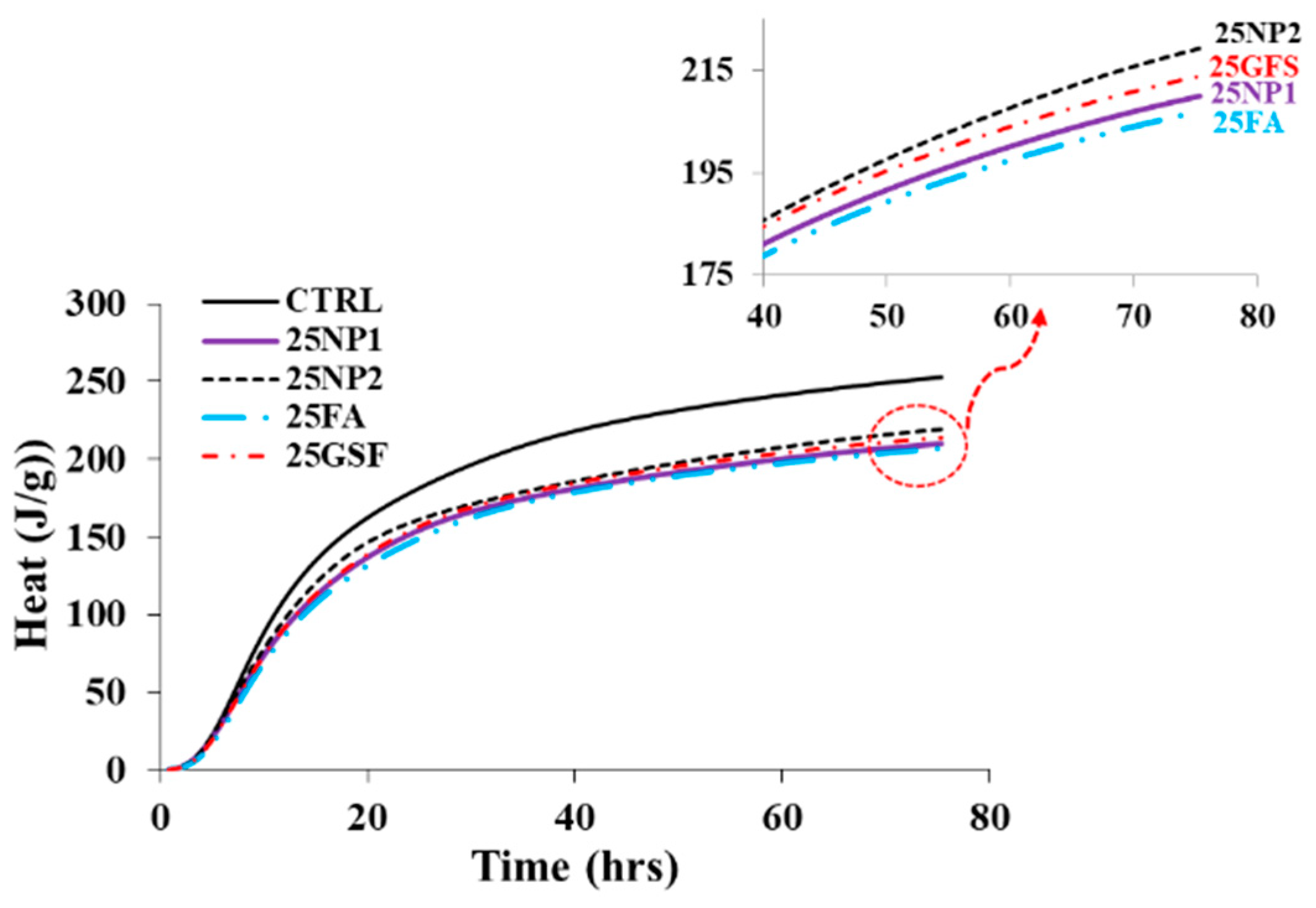
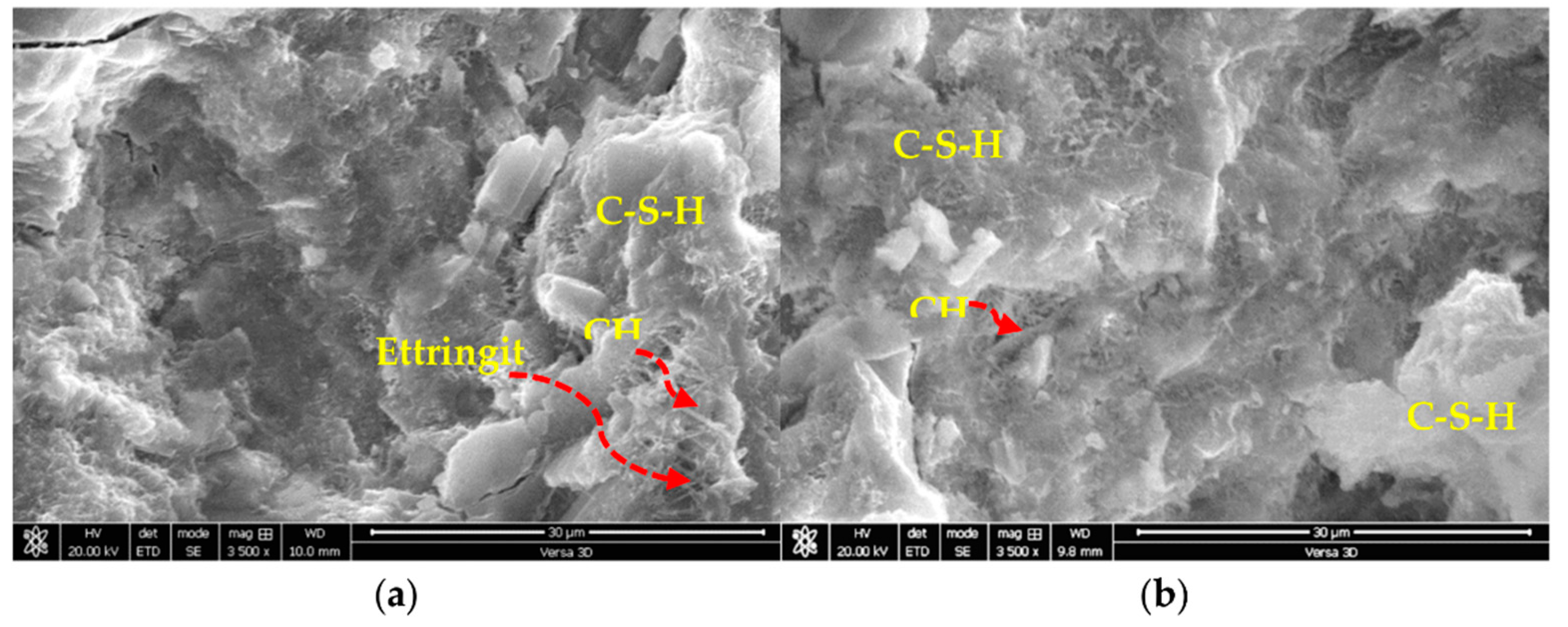
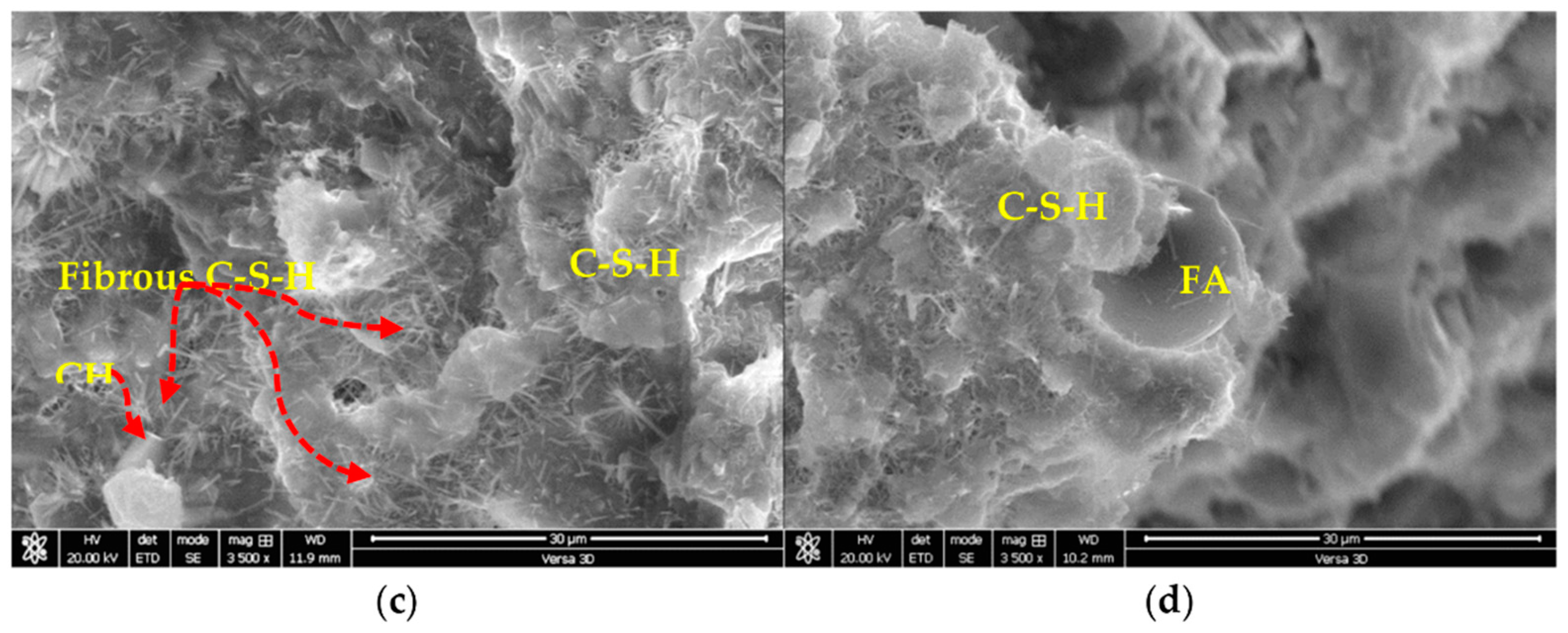
| PC | NS | CS | CA10 | CA20 | Water |
|---|---|---|---|---|---|
| 350 | 510 | 270 | 315 | 735 | 175 |
Publisher’s Note: MDPI stays neutral with regard to jurisdictional claims in published maps and institutional affiliations. |
© 2022 by the authors. Licensee MDPI, Basel, Switzerland. This article is an open access article distributed under the terms and conditions of the Creative Commons Attribution (CC BY) license (https://creativecommons.org/licenses/by/4.0/).
Share and Cite
Fares, G.; Alhozaimy, A.M. Assessment of Pozzolanic Activity of Ground Scoria Rocks under Low- and High-Pressure (Autoclave) Steam Curing. Materials 2022, 15, 4666. https://doi.org/10.3390/ma15134666
Fares G, Alhozaimy AM. Assessment of Pozzolanic Activity of Ground Scoria Rocks under Low- and High-Pressure (Autoclave) Steam Curing. Materials. 2022; 15(13):4666. https://doi.org/10.3390/ma15134666
Chicago/Turabian StyleFares, Galal, and Abdulrahman M. Alhozaimy. 2022. "Assessment of Pozzolanic Activity of Ground Scoria Rocks under Low- and High-Pressure (Autoclave) Steam Curing" Materials 15, no. 13: 4666. https://doi.org/10.3390/ma15134666
APA StyleFares, G., & Alhozaimy, A. M. (2022). Assessment of Pozzolanic Activity of Ground Scoria Rocks under Low- and High-Pressure (Autoclave) Steam Curing. Materials, 15(13), 4666. https://doi.org/10.3390/ma15134666








